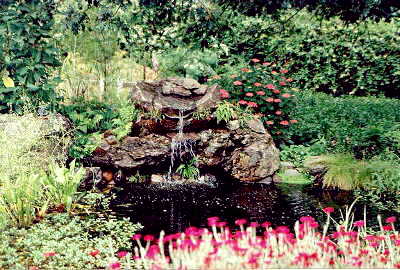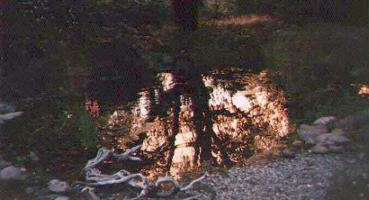THE BIGGS' WILDLIFE POND: 1997
This page first appeared as an article in the January IPS (Internet Pond Society) Reflections Pond Tours column. The IPS is now defunct though, but this explains why the article is written in the 2nd person!
Our tour this month brings us back to the Biggs pond to see all the
changes and improvements made since our visit to their pond one year
ago
when it looked like this thumbnail to the right (click on all pictures in this tour to enlarge
them).
This pond was built in a hole that used to be the deep end of an above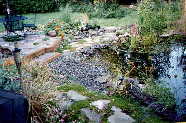 ground pool. The deep area is roughly 32 inches deep with shelves
created by placing sandbags in between the old blue pool liner and an
inexpensive black liner to make it look more realistic. The shallow end
naturalizes into a beach area.
ground pool. The deep area is roughly 32 inches deep with shelves
created by placing sandbags in between the old blue pool liner and an
inexpensive black liner to make it look more realistic. The shallow end
naturalizes into a beach area.
Newly added this year has been the waterfall. By stacking three huge
boulders (~2 tons total), threading a plastic pipeline between the
crevasses to the top, and adding some carefully placed flat
flagstone, they have created a waterfall drop of about 3 feet, and
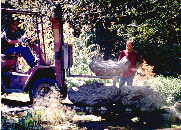 the soothing sound of flowing water. A small water bowl created at the
top is a favorite spot for birds to drink and bathe. The Biggs feel
that the movement of the water has allowed them to keep algae growth to
a minimum without adding a filter.
the soothing sound of flowing water. A small water bowl created at the
top is a favorite spot for birds to drink and bathe. The Biggs feel
that the movement of the water has allowed them to keep algae growth to
a minimum without adding a filter.
The plants have flourished over the past year, looking lush and natural.
Most are native to California and Sonoma County. They tell us how much
fun it has been to collect plants and rocks from the roadsides locally
to be used to naturalize the pond. They remind us, "Never take native
plants from private property unless you have permission, and never ever
from parks!"
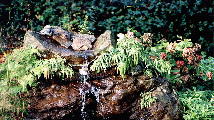 The waterfall looks like a natural part of the landscape and is
planted with 5-finger ferns in between the boulders. Curious how they
were able to naturalize this area so quickly, Kathy explained how
they created an envelope of chicken wire, lined it with black plastic,
filled it with soil and placed it around the waterfall boulders to fill
in the empty spaces between the boulders. Sphagnum moss was tucked
between the plastic and the chicken wire. This made the wire virtually
invisible.
The waterfall looks like a natural part of the landscape and is
planted with 5-finger ferns in between the boulders. Curious how they
were able to naturalize this area so quickly, Kathy explained how
they created an envelope of chicken wire, lined it with black plastic,
filled it with soil and placed it around the waterfall boulders to fill
in the empty spaces between the boulders. Sphagnum moss was tucked
between the plastic and the chicken wire. This made the wire virtually
invisible.
To the right of the waterfall is the newly added shady bog area which
is filled with foxglove, 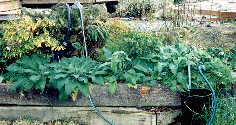 Douglas iris, forget-me-nots, azaleas, and more ferns. A
tier of railroad ties behind the waterfall holds in soil and this area
is planted with huckleberries and a non-native Japanese maple which a
friend gave them.
Douglas iris, forget-me-nots, azaleas, and more ferns. A
tier of railroad ties behind the waterfall holds in soil and this area
is planted with huckleberries and a non-native Japanese maple which a
friend gave them.
We notice that Creeping Primrose is bountiful in the Biggs pond.
Kathy tells us that its floating 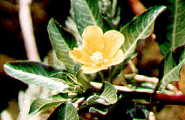 leaves not only help shade the pond
but are a favorite spot for dragonflies to lay their eggs. Among
the marginals we see pennywort,
leaves not only help shade the pond
but are a favorite spot for dragonflies to lay their eggs. Among
the marginals we see pennywort, 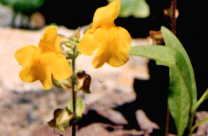 optic-fiber grass, cattails, horsetails,
marestail (lots of tails), blue pickerel, water plantain, lobelia,
marsh marigold and parrots feather. The borders are softened by some of
the marginals, but also by mint, monkey flower, water cress, bog
orchid, yellow flag, Indian rhubarb and others. ALL are NATIVES or
naturalized locally!
optic-fiber grass, cattails, horsetails,
marestail (lots of tails), blue pickerel, water plantain, lobelia,
marsh marigold and parrots feather. The borders are softened by some of
the marginals, but also by mint, monkey flower, water cress, bog
orchid, yellow flag, Indian rhubarb and others. ALL are NATIVES or
naturalized locally!
The Biggs pond was originally stocked with mosquito fish supplied by
the local Mosquito Abatement Department and supplemented by some more
netted out of a local waterway. At this time they also added about 25 1"
catfish fry found in the same spot. Thinking they all perished they
pointed out to us a lone survivor - 7 inches long one year later!
Kathy tells us about "Orfie" nicknamed the "world's ugliest pond comet". They suspect
he arrived as an egg on a plant from the pond nursery!
They added 6 feeder comets to keep him company, but later found 4
floating belly up. They figured they had all died until 4 months
later when they saw him swimming happily among the cabomba, elodea,
hornwort and sagitttaria, with a 4 inch comet they have now named Goldie.
By that time, "Orfie" had grown to nine inches!!
Sitting on the brand new flagstone patio The Biggs tell us how they have
always loved water and wildlife and wanted to achieve a natural environment
for wildlife in their own yard. The pond is designed to create the
illusion it is natural . It is situated under a Black Oak tree despite
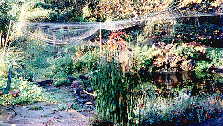 advice to the contrary. Kathy and her husband love this location, and
have even designed an unobtrusive support to go up each fall from which
they hang bird netting. This catches 90% of the leaves from the tree
and keeps the pond from being 'poisoned' by the deteriorating oak
leaves.
advice to the contrary. Kathy and her husband love this location, and
have even designed an unobtrusive support to go up each fall from which
they hang bird netting. This catches 90% of the leaves from the tree
and keeps the pond from being 'poisoned' by the deteriorating oak
leaves.
Kathy
explains how building
this pond has lead her to other ventures.
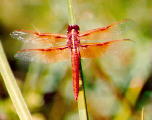
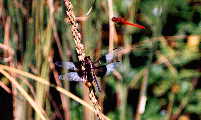 "First we had to research
building the pond, then native plants, and then I started identifying
the animals that came to visit. That lead to creating a
pond web-site
(and learning some HTML). This
lead to a site listing the Critters who visit and learning to scan photos. I discovered that
there were no identification guides for dragonflies for the western USA
and so I've begun to create one for California on line! Visit our dragonfly site. Next I hope
to begin leading dragonfly walks for our local Audubon chapter!"
"First we had to research
building the pond, then native plants, and then I started identifying
the animals that came to visit. That lead to creating a
pond web-site
(and learning some HTML). This
lead to a site listing the Critters who visit and learning to scan photos. I discovered that
there were no identification guides for dragonflies for the western USA
and so I've begun to create one for California on line! Visit our dragonfly site. Next I hope
to begin leading dragonfly walks for our local Audubon chapter!"
Kathy and her husband love the peace and serenity their pond provides. After we all 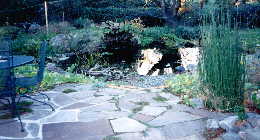 watch the
sunset being reflected on the pond, the sun sets further and as night falls
they turn on the spotlight behind the falls. We notice how the
branches of the Black Oak tree reflect and dance on the water doubling the tree's
beauty at night.
watch the
sunset being reflected on the pond, the sun sets further and as night falls
they turn on the spotlight behind the falls. We notice how the
branches of the Black Oak tree reflect and dance on the water doubling the tree's
beauty at night.
The Biggs wish us goodnight and we can't help but wonder what changes the next year will bring!
